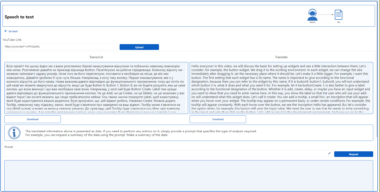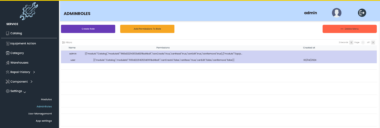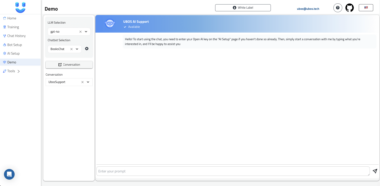Spotify MCP Server: Bridging the Gap Between Music and AI Agents
The Spotify MCP Server is a Node.js-based application designed to seamlessly integrate the Spotify Web API with the Model Context Protocol (MCP). This powerful combination unlocks a new realm of possibilities for interacting with Spotify programmatically, enabling AI Agents and other applications to access and control Spotify’s vast music library through a standardized interface. Built to leverage the UBOS platform, this server provides a robust and efficient way to manage Spotify content and playback within a larger AI ecosystem.
At its core, the Spotify MCP Server acts as a bridge, translating MCP requests into Spotify API calls and vice versa. This allows developers to create AI-powered applications that can:
- Search for tracks: Find the perfect song or artist based on user input.
- Control playback: Start, stop, pause, and skip tracks.
- Manage playlists: Retrieve and organize user playlists.
- Get current playback state: Know what’s currently playing and on which device.
This functionality is exposed through a set of well-defined MCP tools, making it easy for AI Agents to interact with Spotify in a consistent and predictable manner. The server also handles authentication with the Spotify API, rate limiting, and error handling, freeing developers from the complexities of directly interacting with the Spotify API.
Key Features:
- MCP Integration: Seamlessly integrates with the Model Context Protocol, providing a standardized interface for interacting with Spotify.
- Spotify Web API Integration: Leverages the Spotify Web API to access and control Spotify’s vast music library.
- Authentication: Handles OAuth authentication with Spotify, simplifying the process of connecting to user accounts.
- Rate Limiting: Implements rate limiting to prevent exceeding Spotify API limits.
- Error Handling: Provides robust error handling to ensure the stability of applications.
- Search Functionality: Allows AI Agents to search for tracks based on various criteria.
- Playback Control: Enables AI Agents to control playback, including starting, stopping, pausing, and skipping tracks.
- Playlist Management: Provides access to user playlists, allowing AI Agents to retrieve and organize them.
- Playback State Retrieval: Allows AI Agents to retrieve the current playback state, including the currently playing track and device.
Use Cases:
The Spotify MCP Server opens up a wide range of use cases for AI Agents and other applications. Here are a few examples:
AI-Powered Music Recommendation Systems:
Imagine an AI Agent that can recommend music based on a user’s current mood, activity, or even the weather. By using the
search_trackstool, the agent can find songs that match the user’s criteria. It can then use theplay_tracktool to start playing the recommended music. Furthermore, leveraging theget_playback_statetool allows the agent to understand the user’s listening habits and refine recommendations over time, creating a personalized and adaptive music experience.This goes beyond simple genre-based recommendations. The AI could analyze lyrics, tempo, and key to understand the emotional content of a song and match it to the user’s current state. It could even learn the user’s preferences for specific artists or albums and prioritize those in its recommendations.
Voice-Controlled Music Players:
Integrate the Spotify MCP Server with a voice assistant to allow users to control their music with voice commands. Users can say things like “Play my favorite playlist” or “Pause the music” and the AI Agent will use the appropriate MCP tools to execute the command. The
get_user_playliststool is crucial for fetching available playlists, whilepause_playbackandplay_trackcontrol the music itself. Error handling ensures that the agent can gracefully respond to ambiguous or invalid commands, providing a user-friendly experience.Advanced voice control could include features like “Play something similar to this song” or “Skip to the next song by this artist.” This requires the AI to analyze the currently playing track and use the
search_trackstool to find similar music, demonstrating the power and flexibility of the Spotify MCP Server.
Smart Home Music Automation:
Automate music playback based on events or triggers in a smart home environment. For example, when a user enters a room, the AI Agent could start playing their favorite music. When the user leaves the room, the agent could pause the music. The
get_playback_statetool allows the agent to monitor the current playback status, whileplay_trackandpause_playbackcontrol the music based on the user’s presence.Consider a more complex scenario where the AI learns the user’s preferences for different times of day. In the morning, it might play upbeat music to help them wake up, while in the evening it might play relaxing music to help them unwind. This level of automation requires the AI to understand the user’s routines and preferences, showcasing the potential for personalized and intelligent music experiences.
Context-Aware Music for Productivity:
An AI Agent could monitor a user’s activity and play music that is conducive to focus and productivity. For example, if the user is working on a complex task, the agent could play instrumental music with a steady tempo. If the user is taking a break, the agent could play more upbeat and energetic music. The
get_playback_statetool allows the agent to monitor the current playback status, whileplay_trackcontrols the music based on the user’s activity.This could be further enhanced by integrating with other productivity tools, such as calendar applications or task management systems. The AI could then understand the user’s schedule and adjust the music accordingly, ensuring that they are always listening to the right music for the right task.
Music-Driven Games and Experiences:
Create interactive games and experiences that are driven by music. For example, a game could change its difficulty or gameplay based on the tempo or mood of the music. The
get_playback_statetool allows the game to monitor the current playback status, whilesearch_trackscan be used to find music that matches the game’s theme or style.Imagine a rhythm game where the player has to tap along to the beat of the music. The game could automatically adjust its difficulty based on the complexity of the song, providing a challenging and engaging experience. This demonstrates the potential for music to be more than just background noise, but an integral part of the gameplay.
These are just a few examples of the many ways that the Spotify MCP Server can be used to create innovative and engaging applications. The possibilities are endless!
Diving Deeper: How UBOS Enhances the Spotify MCP Server
The UBOS platform provides a comprehensive environment for developing, deploying, and managing AI Agents. When used in conjunction with the Spotify MCP Server, UBOS unlocks even greater potential. Here’s how:
Orchestration: UBOS allows you to orchestrate multiple AI Agents, creating complex workflows that involve the Spotify MCP Server. For example, you could create an agent that listens to user voice commands, uses the Spotify MCP Server to find and play music, and then provides feedback to the user based on their listening habits. This orchestration capability enables you to build sophisticated and personalized music experiences.
Data Integration: UBOS allows you to connect the Spotify MCP Server with other data sources, such as user profiles, social media feeds, and calendar events. This allows you to create AI Agents that are more context-aware and can provide more relevant and personalized music recommendations. For example, you could create an agent that plays different music based on the user’s location, the time of day, or their upcoming appointments.
Custom AI Agent Development: UBOS provides a suite of tools for building custom AI Agents, including natural language processing (NLP) engines, machine learning (ML) models, and dialog management systems. This allows you to create highly specialized agents that are tailored to specific use cases. For example, you could create an agent that can understand complex music requests, such as “Play something that sounds like Radiohead but is more upbeat,” or an agent that can automatically create playlists based on a user’s listening history.
Multi-Agent Systems: UBOS supports the creation of multi-agent systems, where multiple AI Agents work together to achieve a common goal. This allows you to create complex and sophisticated music experiences that would be impossible to achieve with a single agent. For example, you could create a system where one agent is responsible for finding music, another agent is responsible for controlling playback, and a third agent is responsible for providing feedback to the user.
In conclusion, the Spotify MCP Server is a powerful tool for integrating Spotify with AI Agents and other applications. When used in conjunction with the UBOS platform, it unlocks even greater potential for creating innovative and engaging music experiences. Whether you’re building a music recommendation system, a voice-controlled music player, or a smart home music automation system, the Spotify MCP Server and UBOS provide the tools you need to succeed.
The UBOS platform empowers businesses to bring AI Agents to every department. By leveraging the Spotify MCP Server within the UBOS ecosystem, you can create AI-driven solutions that enhance employee productivity, improve customer engagement, and drive innovation across your organization.
Installation and Setup
Setting up the Spotify MCP Server is straightforward. Follow these steps to get started:
Prerequisites: Ensure you have Node.js (v16 or higher) and npm installed. You’ll also need a Spotify Developer Account with app credentials.
Clone the Repository: Clone the repository to your local machine using
git clone <repository-url> && cd spotify-mcp.Install Dependencies: Navigate to the cloned directory and run
npm installto install the necessary dependencies.Configure Environment Variables: Create a
.envfile in the root directory and add your Spotify Client ID, Client Secret, and Redirect URI. The Redirect URI must match the one configured in your Spotify Developer app settings. Example:env SPOTIFY_CLIENT_ID=your_spotify_client_id SPOTIFY_CLIENT_SECRET=your_spotify_client_secret SPOTIFY_REDIRECT_URI=http://localhost:8888/callback
Build the Server: Run
npm run buildto build the server.Start the Server: Run
npm startto start the server. This will open a browser for Spotify authentication and initiate the server using stdio transport.
With the server up and running, you can now integrate it with your UBOS AI Agents and start exploring the possibilities of AI-powered music experiences.
Spotify MCP Server
Project Details
- rakshitha2207/spotify-mcp
- Last Updated: 3/17/2025
Recomended MCP Servers
Playwright MCP fork that works with Cloudflare Browser Rendering
MCP server for eSignatures (https://esignatures.com)
Connect AI agents to the Paradex trading platform. Retrieve market data, manage accounts, and execute trades seamlessly. Enhance...
Paybyrd AI Agent Toolkit: A Node.js library that integrates Paybyrd payment processing services with AI models. Create payment...
A Model Context Protocol (MCP) server that provides chart tools, allowing it to interact with the quick chart...
Asset Price MCP Server

A simple MCP server for Wordpress Elementor

MCP Server for journaling

MCP Server Typescript Template
 From vibe coding to vibe deployment. UBOS MCP turns ideas into infra with one message.
From vibe coding to vibe deployment. UBOS MCP turns ideas into infra with one message.





